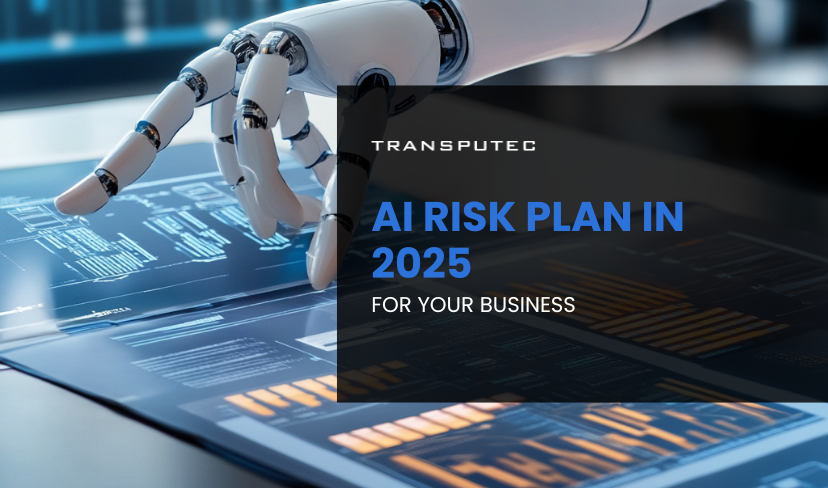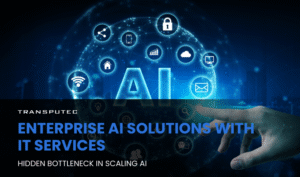Written by KRITIKA SINHA | MARKETING
As artificial intelligence (AI) continues to revolutionise industries, businesses face a double-edged sword: unprecedented opportunities for growth and efficiency, coupled with new and complex risks. In 2025, the AI landscape is more intricate than ever, with 72% of organisations now using some form of AI, up 17% from 2023.
However, this rapid adoption comes with a caveat: 96% of leaders believe that adopting generative AI makes a security breach more likely. These statistics underscore a critical need: every business must develop and implement a comprehensive AI Risk Plan. This blog will explore the importance of AI risk management, potential pitfalls, and how Transputec can guide your organisation through this complex terrain.
Understanding the Need for an AI Risk Plan
The term “AI Risk Plan” refers to a strategic framework designed to identify, assess, and mitigate potential risks associated with AI implementation. As AI systems become more sophisticated and integral to business operations, the need for such a plan becomes paramount.
An effective AI Risk Plan addresses not only technical vulnerabilities but also ethical considerations, regulatory compliance, and potential societal impacts.
Key Components of an AI Risk Plan
1. Risk Identification and Assessment
The first step in creating an AI Risk Plan is to identify and assess potential risks. This involves:
- Analysing data sources and quality
- Evaluating algorithmic bias
- Assessing security vulnerabilities
- Considering ethical implications
- Examining regulatory compliance requirements
2. Mitigation Strategies
Once risks are identified, the AI Risk Plan should outline specific strategies to mitigate them. This may include:
- Implementing robust data governance practices
- Developing ethical guidelines for AI development and use
- Enhancing cybersecurity measures
- Establishing clear accountability frameworks
- Regular auditing and testing of AI systems
3. Continuous Monitoring and Adaptation
An effective AI Risk Plan is not static. It requires ongoing monitoring and adaptation to address emerging risks and changing regulatory landscapes. This involves:
- Regular risk assessments
- Staying informed about AI advancements and potential threats
- Updating mitigation strategies as needed
- Fostering a culture of responsible AI use within the organisation.
Would You like Assistance with Artificial Intelligence?
Connect with us today for our free consultation!
Benefits of Implementing an AI Risk Plan
1. Enhanced Cybersecurity
By conducting regular risk assessments and implementing mitigation strategies, organisations can significantly improve their cybersecurity posture. It helps identify potential vulnerabilities before they can be exploited, reducing the likelihood of data breaches and cyberattacks.
2. Improved Decision-Making
A well-crafted plan provides a framework for more informed decision-making regarding AI deployment. It helps balance the desire for innovation with the need for risk mitigation, ensuring that AI initiatives align with overall business objectives and risk tolerance.
3. Regulatory Compliance
With the increasing focus on AI governance, such as the EU Artificial Intelligence Act and the Biden administration’s executive order on AI safety, an AI Risk Plan is crucial for maintaining regulatory compliance. It helps organisations navigate complex legal requirements and avoid potential penalties.
4. Enhanced Trust and Reputation
By prioritising responsible AI use and transparent risk management, businesses can build trust with customers, partners, and stakeholders. This proactive approach to AI governance can significantly enhance an organisation’s reputation in an increasingly AI-driven marketplace.
5. Competitive Advantage
Organisations that effectively manage AI risks are better positioned to harness the full potential of AI technologies. An AI Risk Plan enables businesses to innovate with confidence, potentially gaining a competitive edge in their industry.
Challenges in Implementing an AI Risk Plan
While the benefits are clear, implementation can present several challenges:
1. Rapidly Evolving Technology:
The fast-paced nature of AI development means that risks and best practices are constantly changing, requiring continuous learning and adaptation.
2. Complexity of AI Systems:
The intricate nature of AI algorithms can make risk assessment and mitigation challenging, often requiring specialised expertise.
3. Resource Allocation:
Developing and maintaining an effective AI Risk Plan requires significant time, financial, and human resources.
4. Balancing Innovation and Risk:
Organisations must strike a delicate balance between leveraging AI for innovation and managing associated risks.
5. Cross-Functional Collaboration:
Effective AI risk management requires collaboration across various departments, including IT, legal, compliance, and business units.
How Transputec Helps with AI Risk Management
Transputec offers comprehensive support in developing and implementing AI Risk Plans:
1. Expert Risk Assessment:
Our team of AI specialists conducts thorough risk assessments tailored to your organisation’s specific AI implementations.
2. Customised Mitigation Strategies:
We develop bespoke risk mitigation strategies that align with your business objectives and risk tolerance.
3. Regulatory Compliance Guidance:
Transputec helps navigate the complex landscape of AI regulations, ensuring your AI initiatives remain compliant.
4. Continuous Monitoring and Support:
We provide ongoing monitoring and support to address emerging risks and adapt your AI Risk Plan as needed.
Conclusion
As we navigate the AI-driven landscape of 2025, the importance of a robust AI Risk Plan cannot be overstated. From enhancing cybersecurity to ensuring regulatory compliance and fostering innovation, an effective AI Risk Plan is crucial for businesses looking to harness the power of AI while mitigating potential risks. By implementing a comprehensive AI Risk Plan, organisations can confidently embrace AI technologies, driving growth and maintaining a competitive edge in an increasingly digital world.
Ready to develop your AI Risk Plan and navigate the complexities of AI implementation with confidence? Contact Transputec today to connect with our AI risk management experts and get started on your journey towards responsible and effective AI adoption.

Ready to protect your AI investments?
Contact Transputec today to connect with our AI risk management experts.
FAQs
How can Transputec help my business develop an AI Risk Plan?
Transputec offers expert risk assessment, customised mitigation strategies, regulatory compliance guidance, continuous monitoring, and comprehensive training programs to help businesses develop and implement effective AI Risk Plans.
What are the key components of an AI Risk Plan?
It typically includes risk identification and assessment, mitigation strategies, and continuous monitoring and adaptation. Transputec can help you develop a plan tailored to your specific business needs.
How often should an AI Risk Plan be updated?
It should be reviewed and updated regularly, ideally at least annually or whenever significant changes occur in your AI systems or the regulatory landscape. Transputec provides ongoing support to ensure your plan remains current and effective.
Can Transputec help with AI regulatory compliance?
Yes, Transputec offers expert guidance on AI regulatory compliance, helping businesses navigate complex legal requirements such as the EU AI Act and other relevant regulations.







